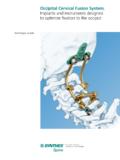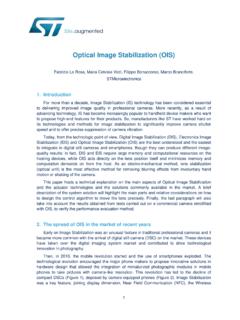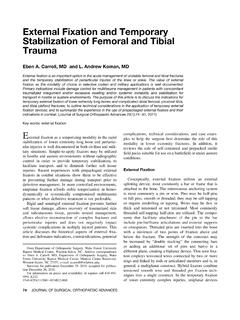Transcription of Synapse System. An enhanced set of instruments and ...
1 instruments and implants approved by the AO FoundationSynapse system . An enhanced set ofinstruments and implants for posteriorstabilization of the upper Guide100 IntroductionSurgical TechniqueProduct InformationTable of ContentsSynapse system 2AO Principles 3 Indications 4 Preparation 5 Technique 7 Additional Techniques 18 Implant Removal
2 26 Assembly Guide 28 Implants 30 instruments 33 Set Lists 40 Image intensifier controlSynthes SpineSynapse SystemThe Synapse system is an enhanced set of instruments and implants, including clamps, top loading variable axis screws,hooks, transconnectors and transverse bars and rods, designedfor posterior stabilization of the upper spine. The implants provide the flexibility required to accommodate variations inpatient Synapse system uses mm and mm rods, allowing components from Synapse , Axon, CerviFix/StarLockand Occipital Cervical Fusion systems to be allows a construct to extend from the occiput to thelower spine using the Universal Spinal system (USS).
3 system features: mm and mm titanium* rods Top loading hooks Top loading transconnectors Square-threaded locking screws Robust polyaxial screws Simple, efficient instrumentation Multiple implant options for crossing the cervicothoracic junction Fully compatible with the OC Fusion system2 Synthes Spine Synapse system Technique Guide*Titanium-6% aluminum-7% niobium alloyRobust polyaxial screws Three diameters with cancellous profile Shaft screws with cortical profile 50 maximum screw angulation50 50 AO PrinciplesIn 1958, the AO formulated four basic principles, which have become the guidelines for internal are: Anatomic reduction Stable internal fixation Preservation of blood supply Early, active mobilizationThe fundamental aims of fracture treatment in the limbs andfusion of the spine are the same.
4 A specific goal in the spineis returning as much function as possible to the injured neural ,3 Synthes Spine 31. M ller, M. Allg wer, R. Schneider, and H. Willenegger. Manual of InternalFixation, 3rd Edition. Berlin: Springer-Verlag. M. Aebi, Thalgott, Webb. AO ASIF Principles in Spine Surgery. Berlin:Springer-Verlag. Synapse system is indicated as follows:Hooks, plate/rods, plates, rods and screwsWhen intended to provide posterior stabilization as anadjunct to fusion of the cervical spine and occipitocervicaljunction (occiput T3), the plate/rod, plates, rod, hook andscrew ( mm cortex) components of the Synthes CerviFix,Axon, OC Fusion and Synapse Systems are indicated forskeletally mature patients using allograft and/or autograft forthe following.
5 Degenerative disc disease (DDD) (defined as neck pain ofdiscogenic origin with degeneration of the disc as con-firmed by patient history and radiographic studies) Spondylolisthesis Spinal stenosis Fracture/dislocation Atlantoaxial fracture with instability Occipitocervical dislocation Revision of previous cervical spine surgery TumorWhen used to treat these cervical and occipitocervical condi-tions, screws are limited to occipital fixation only. Hooks and rodsThe rod and hook components are also intended to providestabilization to promote fusion following reduction of frac-ture/dislocation or trauma in the cervical/upper thoracic (C1 T3) , clamps, screws, nuts, variable axis screws, lockingscrews, and transverse barsThe rods, clamps, screws, nuts, variable axis screws, lockingscrews, and transverse bars are intended to promote fusionfollowing reduction of fracture/dislocation or trauma in theupper thoracic spine (T1 T3).
6 The use of these screws ( mm, mm and mm cancellous, and mm and mm cortex) is limited toplacement in T1 T3 in treating thoracic conditions only. They are not intended to be placed in or treat conditions involving the cervical Synthes Spine Synapse system Technique GuideThe Synthes CerviFix, Axon, and Synapse Systems can alsobe linked to the Synthes Universal Spinal system using mm and mm parallel connectorsfrom that system and via the CerviFix tapered rods usinglamina hooks, transverse process hooks, pedicle hooks, mm screws and the mm parallel : This device is not intended for screw attachmentor fixation to the posterior elements (pedicles) of the cervi-cal, thoracic (T4 T12), or lumbar spine. ContraindicationsContraindications for the use of the Synthes CerviFix, Axon,and Synapse Systems include: Active systemic infection or an infection localized to thesite of the proposed implantation.
7 Severe osteoporosis may prevent adequate fixation of thescrews and preclude the use of this or any other spinal in-strumentation system . Patients who have been shown to be safely and pre-dictably treated without internal fixation. Open wounds Foreign body sensitivityMental or physical impairment, which compromises or pre-vents a patient s ability to comply with necessary limitationsor precautions, may place that patient at a particular riskduring postoperative such as the patient s weight, activity level, and ad-herence to weight bearing or load bearing instructions havean effect on the stresses to which the implant is factors which may preclude the possibility of fu-sion include any underlying physiological conditions such askidney dialysis, cancer, osteopenia, smoking, or CerviFix, Axon, and Synapse Systems (hooks)
8 Are con-traindicated for use in postlaminectomy refer to package insert for the full list of indications, contraindications,warnings and/or Synthes Spine 51 PreparationRequired Synapse Instrument and Titanium Implant Synapse mm Instrument and TitaniumImplant SetOptional Occipital Cervical Fusion Instrument andTitanium Implant patientPatient positioning is critical for cervical posterior fusion procedures. Place the patient on the operating table in theprone position with the patient s head securely patient position should be confirmed via direct visuali-zation prior to draping and by use caution when positioning the patient, as physio-logic alignment may not be Synthes Spine Synapse system Technique GuidePreparation continued4 ApproachUse the standard surgical approach to expose the spinousprocesses and laminae of the vertebrae to be planningAll necessary imaging studies should be available to plan implant placement and visualize individual patient screw and drill guide mm Drill Bit with 65 mm stop, quick Drill Guide with graduation.
9 For mm Drill mm Drill Bit with 65 mm stop, quick coupling Drill Guide with graduation, for mm Drill BitSelect the drill bit and drill guide that correspond to thescrew diameter to be used. The mm and mm screwshave the same core diameter ( mm) and require the useof the same drill bit and drill guide, identified with a yellowband. The mm screws have a larger core diameter ( mm) and require the use of the drill bit and drill guideidentified with a light blue color band. See table at Technique Synthes Spine 71 Start screw Awl Determine the entry point and trajectory for the screw anduse the awl to create a pilot hole.
10 This helps to prevent dis-placement of the drill bit during initial Diameter Drill Bit Drill Guide mm mm mm Synthes Spine Synapse system Technique GuideSurgical Technique continued3 Set drill guide Drill Guide with graduation, for mm Drill Drill Guide with graduation, for mm Drill BitTo set the drill guide to the desired depth, slide back thelatch to release the inner tube; align the distal end of the in-ternal drill guide tube with the appropriate depth calibrationon the window. Release the latch to lock the drill guide atthe desired * Drill Guide, 14 mm, for mm drill bitA drill guide with a fixed depth of 14 mm is additionallyavailable for mm and mm screws.







